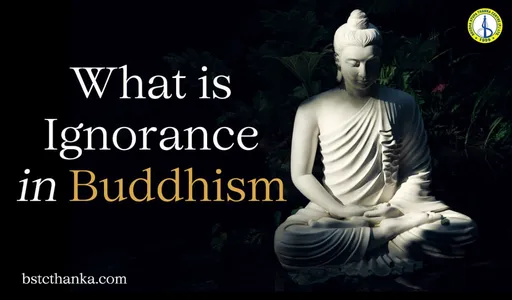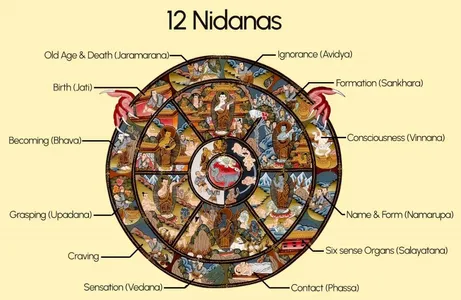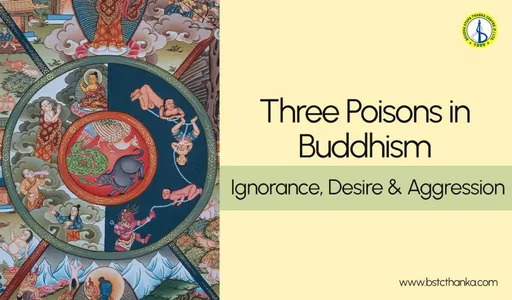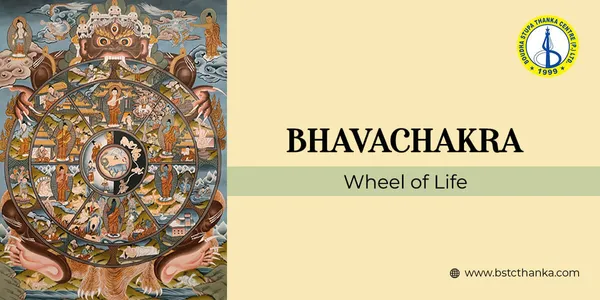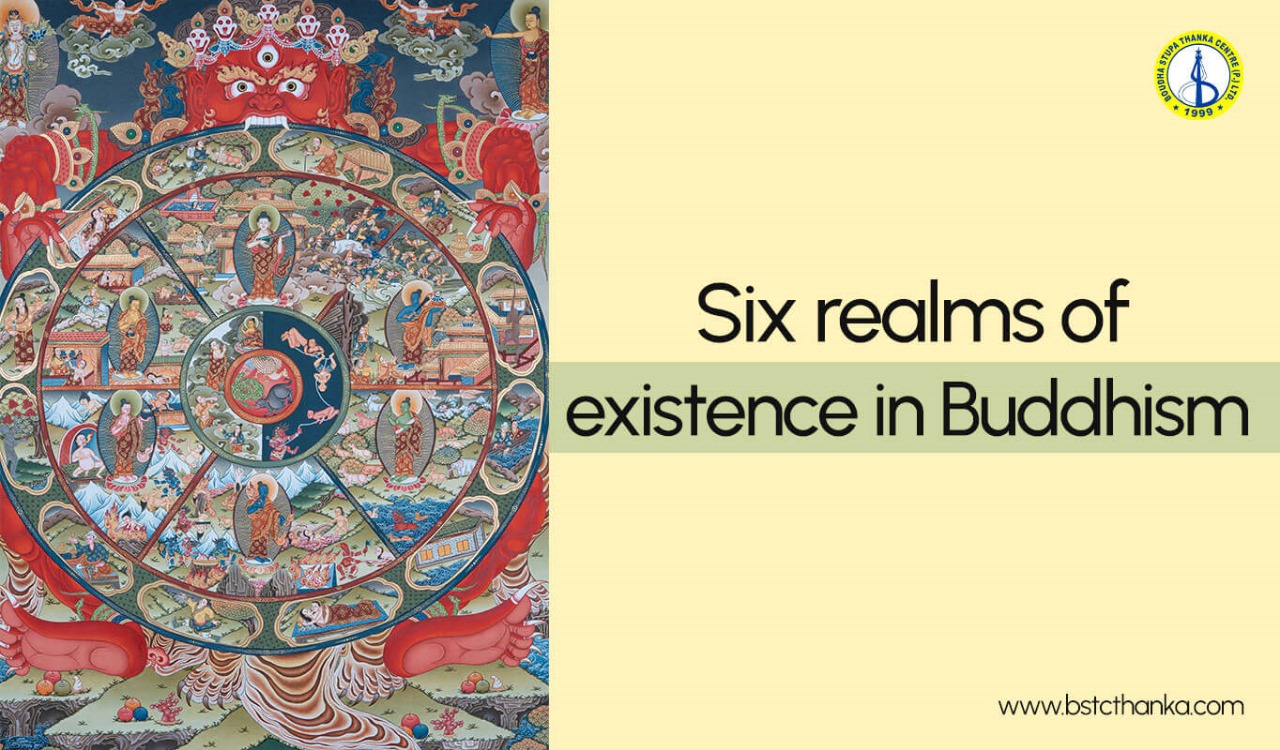
What are the Six Realms of Existence in Buddhism?
In the world of religious belief, the concept of heaven and hell is a familiar one. However, in the teachings of Buddhism, the view of the afterlife is quite different. Rather than a simple binary of good and bad, the Buddhist tradition speaks of the "Six Realms of Existence" - a complex and fascinating vision of the different states of being that a person can inhabit.
In the Wheel of Life Thangka painting, these Six Realms(6 States of Existence) are vividly illustrated around the inner circle, each representing a different state of being. The 6 realms of buddhism are the God Realm, the Demi-God Realm, the Animal Realm, the Hell Realm, the Hungry Ghost Realm, and the Human Realm. Each realm reflects a unique condition of existence, from divine bliss to intense suffering. In this blog, we'll delve into each of these realms in detail, exploring their significance and how they contribute to the Buddhist understanding of life and rebirth.
6 Realms of Buddhism in Wheel of Life
The Wheel of Life, or Bhavachakra in Buddhism, is a symbolic representation of the cycle of birth, life, death, and rebirth in Buddhism. At the heart of this wheel are the Six Realms of Existence, each depicting a different state of being influenced by one’s karma. The six realms of existence are arranged in the Wheel in relation to the three poisons of greed, hatred, and delusion. Let’s delve into these realms to understand the diverse experiences and lessons they offer.
1. God Realm
The God Realm, depicted at the top of the Wheel of Life or Bhavacakra in Buddhism, is a state of great pleasure and comfort. In God realm, beings enjoy immense happiness, luxury, and power. They live in divine palaces and experience almost no suffering, making this realm appear to be the ultimate paradise.
However, life in the God Realm is not without its challenges. Despite the joy and ease, beings here are still subject to the cycle of birth and rebirth. Their happiness is temporary, and they can become complacent, which prevents them from progressing spiritually. Eventually, the pleasures of this realm fade, and beings may fall to lower realms as their good karma diminishes.
2. Demi-God Realm
Alongside the God Realm at the top of the Wheel of Life, we find the Demi-God Realm or Asura Loka. The beings who inhabit this realm are known as Asuras, and they possess great strength, power, and martial abilities. They live in a state of partial satisfaction, enjoying many pleasures, but they are always driven by jealousy and a desire to surpass the gods above them.
While Demi-Gods have many advantages, their lives are filled with conflict and strife. They are often caught up in battles and struggles, both with other Demi-Gods and their inner desires. This ongoing tension and dissatisfaction keep them from finding true peace and happiness, trapping them in a cycle of rivalry and unrest.
3. Animal Realm
The animal realm lies just below the demi-god realm in the Wheel of Samsara. The animal realm is a state where beings are reborn as animals due to their past karma. Animals in this realm focus on survival, such as finding food, shelter, and safety. They live mostly in the present moment, driven by their natural urges, and often lack the ability to think about their actions or their consequences deeply.
The Animal Realm is marked by fear, hunger, and a lack of understanding. Beings here struggle to find food and shelter, and they often face danger from predators or humans. They can't easily learn or grow spiritually because they're focused on staying alive. Buddhists believe that beings in this realm suffer because they can't see beyond their immediate needs.
4. Hell Realm
The hell realm is the most challenging of the six realms in Buddhism.The Hell Realm is situated at the bottom of this wheel, indicating the most intense and challenging state of existence. It is a place where beings are reborn due to their negative karma. Beings in the Hell Realm endure extreme pain, often described as burning heat or freezing cold.
Life in the Hell Realm is marked by constant agony and fear. The suffering is a result of past harmful actions, and beings remain in this realm until their negative karma is exhausted1. Despite the intense suffering, it is not eternal; once the negative karma is fully experienced, beings can be reborn into other realms.
5. Hungry Ghost Realm
The Hungry Ghost Realm is usually located just above the Hell Realm in the wheel, representing a state of existence where suffering is significant but different from the extreme torment of hell.
The Hungry Ghost Realm is marked by beings who experience intense cravings and unfulfilled desires. These beings are often depicted with large, empty stomachs and tiny mouths, making it nearly impossible for them to satisfy their hunger or thirst. Their lives are filled with frustration and dissatisfaction, as they struggle to get what they need but can never truly find relief. This realm highlights the consequences of greed and attachment, serving as a powerful lesson on the importance of overcoming excessive desire.
6. Human Realm
The Human realm is considered the most favorable for spiritual progress because humans have the unique ability to understand and practice the teachings of the Buddha. The human realm is situated between the higher realms of gods and the lower realms of animals, hungry ghosts, and hell beings.The mid-position between higher and lower realms reflects a unique balance of suffering and pleasure, which provides an opportunity for spiritual growth and enlightenment.
The Human Realm is characterized by a blend of joy and suffering, which allows people to learn and evolve. Unlike beings in the lower realms, humans have the potential for self-awareness and wisdom. They experience a wide range of emotions and situations that can lead to spiritual growth if approached with the right mindset. The Human realm is also noted for its complexity and potential for positive action, giving humans the chance to cultivate virtues and work towards bettering their lives.
What Does 6 Realms of Existence Teach Us?
The Buddhist teachings about the 6 realms of existence provide important lessons for how we should live our lives. These 6 realms represent different states of being that all living beings can experience.
The key lesson is that our actions and mindset determine the realm in which we are reborn. If we live with greed, hatred, and ignorance, we may be reborn in the lower realms, like the hell realm or the hungry ghost realm, where there is a lot of suffering. However, suppose we cultivate virtues like compassion, generosity, and wisdom. In that case, we have a better chance of being reborn in the higher realms, like the god realm or the human realm, where we have more freedom and opportunity for spiritual growth. The ultimate goal is to break free from this cycle of rebirth and attain enlightenment.
Also Read: What Are the 12 Links of Nidanas?
Conclusion
The Six Realms of Buddhism offer a profound understanding of the different states of being that one can experience. Each realm, from the God Realm's divine bliss to the Hell Realm's intense suffering, illustrates the consequences of our actions and the influence of karma. By exploring these realms, we gain insight into the Buddhist perspective on life, death, and rebirth and learn valuable lessons about the nature of suffering, happiness, and spiritual growth. The understanding of the 6 realms encourages us to live mindfully and compassionately, striving for enlightenment and liberation from the cycle of rebirth.
FAQs
What are the Six Realms of Existence in Buddhism?
The Six Realms of Existence in Buddhism are states of being that include the God Realm, Demi-God Realm, Human Realm, Animal Realm, Hungry Ghost Realm, and Hell Realm. Each realm reflects different experiences based on one’s karma.
How do the Six Realms relate to karma?
Each realm is influenced by one's karma, or actions. Good actions can lead to rebirth in higher realms, while harmful actions can result in rebirth in lower realms, where there is more suffering.
Why is the Human Realm important in Buddhism?
The Human Realm is important because it offers a balance of pleasure and pain, making it the best place for spiritual growth and the pursuit of enlightenment.
Can beings move between the Six Realms?
Yes, beings can move between realms based on their actions and karma. For instance, good karma can lead to rebirth in a higher realm, while negative karma can result in a lower realm.
How can we avoid being reborn in the lower realms?
According to Buddhism, we can avoid rebirth in the lower realms, such as the Hell Realm or Hungry Ghost Realm, by cultivating virtues like compassion, generosity, and wisdom. By living with a positive mindset, we increase our chances of being reborn in the higher realms where we have more freedom and opportunity for spiritual growth.




